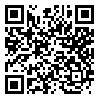Volume 6, Issue 3 (10-2019)
Human Information Interaction 2019, 6(3): 1-16 |
Back to browse issues page
Download citation:
BibTeX | RIS | EndNote | Medlars | ProCite | Reference Manager | RefWorks
Send citation to:



BibTeX | RIS | EndNote | Medlars | ProCite | Reference Manager | RefWorks
Send citation to:
Amiri N, Riahinia N, Arastoopoor S, Haji Zeinolabedini M, Alimohammadi D. Analysis of IFLA Library Reference Model’s Entities and Attributes For Iranian Traditional Music Resources (Case study: Morq-e sahar Song). Human Information Interaction 2019; 6 (3)
URL: http://hii.khu.ac.ir/article-1-2898-en.html
URL: http://hii.khu.ac.ir/article-1-2898-en.html
Nahid Amiri 
 , Nosrat Riahinia
, Nosrat Riahinia 
 , Sholeh Arastoopoor
, Sholeh Arastoopoor 
 , Mohsen Haji Zeinolabedini
, Mohsen Haji Zeinolabedini 
 , Dariush Alimohammadi
, Dariush Alimohammadi 


 , Nosrat Riahinia
, Nosrat Riahinia 
 , Sholeh Arastoopoor
, Sholeh Arastoopoor 
 , Mohsen Haji Zeinolabedini
, Mohsen Haji Zeinolabedini 
 , Dariush Alimohammadi
, Dariush Alimohammadi 

Abstract: (9862 Views)
Background and Aim: The object of the study was to Analyze IFLA Library Reference Model (LRM) Entities and Attributes for Iranian Traditional Music Resources, Case Study: Morq-e Sahar Song.
Method: The study inherits an applied content analysis method. All Entities and Attributes of IFlA LRM Model based on two checklists include: Final report of IFlA LRM on August 2017 and Transition Mappings User Tasks, Entities, Attributes, and Relationships in FRBR, FRAD, and FRSAD mapped to their equivalents in the IFLA Library Reference Model Analyzed for Morq-e Sahar Song data elements. The research sample size involves Fifty different performances of Morq-e sahar Song.
Results: The results show that all the eleven Entities and the Thirty -Seven Attributes of IFLA-LRM except for Cartographic scale attribute parallels in Morq-e sahar song data elements.
Conclusion: As a first step, the results of the study in identifying conveniences of this model for organizing traditional Iranian music resources, realizing IFlA LRM Model’s Entities and Attributes which is appropriate in Iranian traditional music organization is operational. The results are also practical for experts of Information organization and designers of Information retrieval system.
Method: The study inherits an applied content analysis method. All Entities and Attributes of IFlA LRM Model based on two checklists include: Final report of IFlA LRM on August 2017 and Transition Mappings User Tasks, Entities, Attributes, and Relationships in FRBR, FRAD, and FRSAD mapped to their equivalents in the IFLA Library Reference Model Analyzed for Morq-e Sahar Song data elements. The research sample size involves Fifty different performances of Morq-e sahar Song.
Results: The results show that all the eleven Entities and the Thirty -Seven Attributes of IFLA-LRM except for Cartographic scale attribute parallels in Morq-e sahar song data elements.
Conclusion: As a first step, the results of the study in identifying conveniences of this model for organizing traditional Iranian music resources, realizing IFlA LRM Model’s Entities and Attributes which is appropriate in Iranian traditional music organization is operational. The results are also practical for experts of Information organization and designers of Information retrieval system.
Keywords: Iranian Music Resources, Music Information Retrieval, IFLA Library Reference Model(IFLA LRM), Traditional music Resources, Morq-e sahar Song.
References
1. Fathian, Akram (2016). Design of metadata ontology pattern of National Library of Iran Catalog base on linked data metho. Ph.D Dissertation, Ferdowsi University of Mashhad.
2. Fattahi, R (2008). From Ideals to Realities: An Analysis of the Most Important Challenges and Approaches to Organizing Information in the Present Time, Library and Information Science, 10 (4), 5-26.
3. Hille Cribbs, Elizabeth (2010). Into the future: FRBR, the Semantic Web, and possible applications for music cataloging. A Master's paper for the M.S. in L.S. degree.
4. Holden, Chris (2013). The Application of FRBR to Musical Works. M.S. Thesis. the University of North Carolina.
5. Kim, Sung-Min (2015). Towards organizing and retrieving classical music based on Functional Requirement For Bibliographic Records (FRBR). Doctoral Dissertation, University of Pittsburgh.
6. Lee, Deborah Theresa (2018). Documenting Performance and Contemporary Data Models: Positioning Performance within FRBR and LRM," Proceedings from the Document Academy:Vol. 5 Available at: http://ideaexchange.uakron.edu/docam/vol5/iss1/2. [DOI:10.35492/docam/5/1/2]
7. Lotfi, Mohamad Reza (1994). Present situation of Iranian Music anf Form in Iranian Music. Adabestan Farhang va Honar, 53, 66-77.
8. LeBoeuf, Patrick (2005). Musical Works in the FRBR Model or 'Quasi la Stessa Cosa: Variations on Theme by Umberto Eco. Cataloging and Classification Quarterly, 39(3/4(, 103-124. [DOI:10.1300/J104v39n03_08]
9. Maxwell, Robert (2008). FRBR: a guide for the perplexed. USA: American Library Association.
10. Mering, M. (2019). IFLA Library Reference Model, RDA, and Serials in a Nutshell. Serials Review, 45(1-2), 66-68 [DOI:10.1080/00987913.2019.1627691]
11. Miller, D. & Le Boeuf, P. (2005). "Such stuff as dreams are made on": How does FRBR fit performing arts? Cataloging & Classification Quarterly, 39(3-4), 151-178. [DOI:10.1300/J104v39n03_10]
12. Parvin, N (2006). Morghe Sahar Song, Bokhara,55, 171-176.
13. Padron, M.F., Cruz, F.W., & Silva, J.R. (2020). Extending the IFLA Library Reference Model for a Brazilian popular music digital library. International Journal on Digital Libraries, 1 - 18. [DOI:10.1007/s00799-020-00277-5]
14. Rilley, Jenn (2011). Leveraging the FRBR model for music discovery and data sharing: autobiographical note. International digital library perspectives, (27)3,175-189 [DOI:10.1108/10650751111164551]
15. Riva, P., Le Boeuf, P., & Zumer, M. (2017a). FRBR-Library reference model. Retrieved December 8, 2017, from http://www.ifla.org/files/assets/cataloguing/frbr-lrm/frbr-lrm_20170817.pdf
16. Riva, P., Le Boeuf, P., & Zumer, M. (2017b). Transition Mappings User Tasks, Entities, Attributes, and Relationships in FRBR, FRAD, and FRSAD mapped to their equivalents in the IFLA Library Reference Model. Retrieved December 8, 2017, from https://www.ifla.org/files/assets/cataloguing/frbr-lrm/transitionmappings201708.pdf.
17. Sepanta, Sasan (1987). History of the Persian musical sound recording. Isfahan:Nima.
18. Smiraglia, Richard P. (1989). Music Cataloging: The Bibliographic Control of Printed and Recorded Music in Libraries. Englewood, Colorado: Libraries Unlimited, Inc.
Send email to the article author
| Rights and permissions | |
 | This work is licensed under a Creative Commons Attribution-NonCommercial 4.0 International License. |




